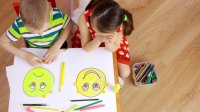Helping Children Develop Emotional Literacy
Exercises that teachers and parents can use to help young children develop the ability to identify emotions.
Your content has been saved!
Go to My Saved Content.Emotional literacy is a key aspect of emotional intelligence and an essential element among social and emotional learning (SEL) skills. It is based largely on vocabulary. Emotion vocabulary is more than word recognition; it shapes how children (and adults) see the world.
Children need a strategic cognitive relational vocabulary for understanding the world around them and for everyday problem solving. If one knows only the words sad, mad, and glad, one will not be able to appreciate all the nuances of relationships and understanding in the world.
have been champions of what they call interpersonal cognitive problem solving (ICPS), which was recently modernized to stand for “I can problem solve.” Shure and Spivack have championed a strategy of focusing on key word pairs used in conversation in everyday social situations.
Build Feelings Vocabulary
Young children should be able to recognize and accurately label these feelings: sad, mad, happy, afraid, surprised, upset, worried, and proud. The best way to check for this ability is to show them pictures of these emotions, using flash cards or the pictures in picture books (such as Dr. Seuss books) and not focusing on the text. First, ask children about the feelings they see in the images. If they’re correct, ask them how they know. Whether they’re correct or not, point out the variety of ways feelings are shown—different aspects of faces (eyes, eyebrows, mouth, forehead) and postures.
Use Key Cognitive Word Pairs
In their research, Shure and Spivack identified key word pairs that are the building blocks of human relationships and problem solving. So much of our complicated, adult understanding stems from these basic distinctions:
- is/is not
- same/different
- can/cannot, may/may not
- and/or, else
- some/all
- before/after
- if/then, might/maybe
- why/because, what happened so that _____ happened next
They suggest that adults explicitly use this terminology when speaking with young children, as well as in activities intended to ensure they understand the meaning of these concepts.
Exploring Same and Different
Anyone familiar with Sesame Street has heard the lyrics, “One of these things is not like the others / One of these does not belong.” This, of course, is a way of teaching same and different. And there are innumerable occasions every day when teachers and parents can help young children make the essential cognitive distinctions that these word pairs represent. Here are three useful classroom activities.
Picture Naming and Rhyming: You will need pictures of a cat, rat, bat, table, chair, and dog. Ask your class, “Who can tell us which pictures sound the same as cat?” Point to:
- All the pictures that sound the same as cat
- Some of the pictures that sound the same as cat
- A picture that does not sound the same as cat
- All the pictures that do not sound the same as cat
Using Alliteration: You will need pictures of a sock, table, book, bag, ball, and bat. Ask the students to look and listen for what the pictures have in common or how they are different. Then point to:
- All the pictures that start with the same sound as book
- Some of the pictures that start with the same sound as book
- Some of the pictures that start with a different sound from book
Just Like Me: Tell the class that you’re going to read a few statements to them. If the statement applies to them, they are to stand up next to their chair. If it does not apply, they are to remain seated. For example, if you say “Who has brown eyes?” all the children with brown eyes should stand up. Those children who don’t have brown eyes should remain seated. Make the point that those who are standing share a characteristic that is the same, and those who are sitting have a characteristic that is different. After you have done some or all of the list below, make the point that the children all have things about them that are the same and they all have things about them that are different.
Read the following statements to the group. After each statement, all children should sit back down. Note that this can be repeated with increasing complexity by adding “and,” “or,” or “not” while adding related statements (e.g., “Stand if you do not have a dog and if you have a brother”). Doing so can promote both cognitive development and listening skills. Here’s a “stand up” example list you can use with young children:
- Have a pet at home
- Have a sister
- Like to read
- Have ever been on an airplane
- Live with a grandparent
- Are x years old
- Like broccoli
- Speak more than one language
- Like roller coasters
- Have a birthday in February
- Play soccer
We now realize now that these and the other skills described earlier all are part of emotional literacy, and we need to start building them in and out of school when our children are young, and continue thereafter.
